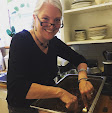
We spent the majority of our week in Burlington, the biggest city in Vermont with a population of 40,000, a lovely place on the banks of Lake Champlain in the upper northwestern third of the state at the foot of the Green Mountains. It's a university town, home of the fighting Catamounts (defined by
Merriam Webster as "any of various wild cats"), which accounts for the young folk wandering the balmy summer streets around midnight.

One of the hot spots downtown is
American Flatbread, just off City Hall Park. Basically a pizza parlor and pub, they're dedicated to local, natural ingredients for the flatbread pizzas they make in the wood-fired oven that sits front and center in the dining room. Comparable to our temples of woodfire like
Ken's or
Nostrana, with Vermont microbrews featured prominently on the beverage menu, this is a place I could get comfortable going to.

A favorite place and one I always return to when we visit the rels is the
Bennington Potters store, featuring made-in-Vermont hand-thrown stoneware pottery. Besides having a great sale and seconds section, this store is chock full of gift items and knick-knacks alongside their traditional splatterware and newer organics collection. It's got the feel of an upscale country store and I just can't resist stopping in and picking up a new piece of pottery whenever we go east.

Like here, farmers markets are a big thing in Vermont with markets happening all over the city several days a week. The difference seems to be that they're not the foodie extravaganzas you find at certain markets here, but more the old-fashioned community market experience, with farmers selling fresh produce, craftspeople selling their wares with a few food vendors sprinkled into the mix. The thing I was surprised at was the variety of produce they had for such a northern climate, with peppers, fennel, beets, corn and fabulous greens.

And no tour of Burlington proper would be complete without mentioning their Waterfront Park, a gorgeous stretch of prime real estate downtown along Lake Champlain that was claimed for the people of Burlington and features a 900-foot boardwalk with a portion of the 7.5 mile bike path running through it. There's a marina with access to ferries that take passengers across the lake, the ECHO Lake Aquarium and Science Center and a multitude of festivals going on all summer.

Then there's the beer. Vermont is all aboard the microbrew bus and it has left the terminal at full throttle. Nearly every pub and restaurant features at least one brew on tap, and several are now bottling. From
Long Trail and
Magic Hat in Burlington to
Otter Creek in Middlebury and
The Alchemist in Waterbury
(photo, left), this place is literally hopping. We sampled several, and while their IPAs don't quite grab your tonsils the way ours do, they've got some mighty fine brews happening there. They've even got a
tour map of the state's breweries for visitors at the
Vermont Brewers Association website for those who want to focus their vacation on liquid pursuits.
Read the rest of the posts in this series: Da Big Cheese!, Twig on a Branch, My First Time, Muddling Through Middlebury and Cheese and Community.

































